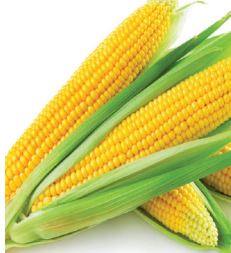
Tomatoes
Tomatoes are packed with carotenoids, including lycopene, which helps give tomatoes their vibrant red color. Research shows that the lycopene present in ocular tissues helps prevent light-induced damage to the retina and other areas of the eye that helps the sight. Tomatoes are also an excellent source of vitamin C, another vision protector. Processed tomato products or fresh tomatoes eaten with a little olive oil will help boost the absorption of lycopene. Researchers say eating foods rich in antioxidants is better than taking supplements.

Corn
Yellow corn is great source of lutein and zeaxanthin. These naturally occurring yellow pigments are lost during ARMD, (Age-related macular degeneration) but research shows that older adults who boost their blood levels of lutein and zeaxanthin through eating foods like corn and other carotenoid-rich fruits and vegetables significantly reduced their risk of losing these pigments. A study even found that women who ate the most fruits and vegetables, including yellow corn, reduced their risk of developing cataracts.
Carrots
can easily be included in your diet in the vegetables salads or fried rice and can also be consumed and enjoyed in its raw form.
Olive Oil
This oil which is low in trans and saturated fat helps prevent retina diseases. Several studies suggest that olive oil is recommended for healthy vision. Not only is olive oil free of trans fats and is low in saturated fat, Australian researchers found that subjects who reported consuming the most olive oil were 48% less likely to develop ARMD.
When buying olive oil, look for extra virgin for the additional antioxidant boost it provides.

Walnuts
Walnuts are the best nut source of omega-3s. In small amounts they can be converted to EPA (eicosapentaenoic acid), another omega-3 fatty acid used by the eye, along with DHA.
They are full of antioxidants and vitamin E, which work to combat inflammation and preserve cardiovascular health. What’s more, walnuts help to lower C-reactive protein, a marker that signals there is inflammation in the body.
Having a handful of walnuts a day can cut your risk of a cardiac event by as much as 50 percent, according to several large research projects, including the ongoing Nurses Health Study.

Berries
Blueberries, blackberries, strawberries, mulberries, cherries and even grapes are outstanding foods for protecting cardiovascular health, which makes them stars for eye health, too. They’re great for lowering both inflammation and blood pressure.
And high blood pressure is a risk factor for macular degeneration. Blueberries and blackberries also contain anthocyanins, which have the dark purple pigments that fight inflammation and improve blood flow. They also help prevent blockages to the arteries that feed oxygen to the retina. Berries don’t grow in Nigeria but they are available though they are a little bit expensive.
Eggs
Eggs contain the omega-3 fatty acid DHA and are the most readily available source of lutein and zeaxanthin. An egg per day for most people, unless you have diabetes, is excellent eye food. Diabetics need to ask their doctor whether eggs can be a part of their diet.
Avocados
Avocados are one the most nutrient rich fruits we eat, so it’s no wonder they’re great for eyes.
They contain lutein and help prevent macular degeneration and cataracts. “They’re also a great source of other important eye nutrients such as beta-carotene, vitamin C, vitamin B6 and vitamin E,” Gerbstadt says. Those vitamins place avocados among the top-10 eye foods.
Turkey
Turkey contains zinc and vitamin B, which makes it effective when it comes to warding off cataract. It is also a healthier option than red meat and tastes great. It is definitely a delicious option for the eyes.
Sweet potatoes
This is a very easy accompaniment to any meal, as it contains loads of beta-carotene which makes them a total necessity when it comes to eye health.
Sardines
Loaded with Omega-3 fatty acids, sardines should be included in your diet at least once a week to get the best benefits out of it. They work by protecting the tiny blood vessels in the eyes and maintaining overall eye health.
According to a study featured in the American Journal of Clinical Nutrition, eating fatty fish can also reduce the risk of developing age–related macular degeneration (AMD).7 If you don’t eat seafood, taking fish oil supplements are other ways you can get a good supply of omega–3 Moringa Moringa leaves contain iron, calcium, potassium, vitamin A, vitamin C and protein.
These are low in calorie, sodium and rich in antioxidant, vitamins, minerals and essential amino acids. Its leaves can also be used to treat various eye problems.
Moringa
The leaves can be used as eye wash and can also be put in eyes. Extract of its fresh leaves juice mixed with honey are also used as eye drop in some parts of India.





